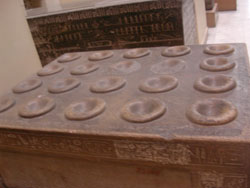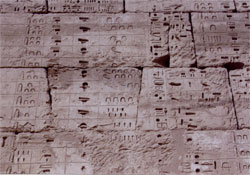

Click on this picture to make it bigger. This is a picture I took in the Cairo Museum in Egypt. This is a very big stone apparatus. Notice the very symetrical and well made cups somehow made into the giant stone square. Many people who are into alien technology think that this stone block was used for creating electricity. Why would someone go to all the trouble of creating this atleast 5 ton stone block, and then making these cups. Some people think a stone sphere was placed in the cups and then somehow they used this device to a practical end. The hieroglyphics on the stone block might give us clues to it's purpose, however no one can acurately read them. To go to all the trouble to build this, I can only imagine that it had an important purpose.

Click on this picture to make it bigger. Look at the complexity of the stone carvings. Clearly the people who did this were very intelligent. It seems to be a very advanced system of either math or some counting system. The people or aliens who did this were obviously very smart. We today don't even have a pictorial language or pictorial counting system. I'm not saying that we need one. But creating one is a very impressive feat. Look at the next picture, it was from the same area. This to me is clearly alien technology or atleast alien intelligence.

Notice the lines on the stones are very accurate, also look at how complex the system is.
Alien Technology Information
Are we using Alien Technology today?
Have we, the human race back-engineered alien technology as a ways of ensuring that we would, at least, have a fighting chance if we were invaded by alien beings? That was the belief of Major Philip J. Corso who stumbled upon alien artifacts sent from Fort Bliss, Texas on 6th July, 1947. He had come across a Corporal off limits in a warehouse and was just about to reprimand him, when the Corporal said 'You won't believe this'. 'What are you talking about?' asked the Major, taking a look inside the open crate. There was no need for the Corporal to answer. The crate, one of several, contained the body of a being, the like of which Corso had never seen before.
'At first I thought it was a dead child they were shipping somewhere' Corso later claimed.'It was a four-foot, human-shaped creature with...bizarre-looking, four fingered hands...and a light-bulb shaped head. The eye sockets were oversized and almond-shaped and pointed down to its tiny nose, which didn't really protrude from its skull'.
Corso looked through the paperwork that accompanied the crate, and found an army intelligence document that described the creature as an inhabitant of a craft that had been retrieved from Roswell, New Mexico, two days earlier on 4th July, 1947. As he shone his torch around the warehouse, he noticed that there were over 30 similar crates stacked against the walls. Major Corso quickly covered the crate with a tarpaulin, and moved outside. He turned to the Corporal and said 'You never saw this and you tell no one'. As far as Corso was concerned, that was the last he ever wanted to see or hear of the crates and their strange contents. But fate would see that their paths would cross again.
By 1961, Philip J. Corso had risen to the rank of Lieutenant Colonel in charge of the Foreign Technology desk in the US Army's Research and Development division at the Pentagon. It was his job to evaluate weapons systems and 'investigate' foreign technology. This included taking apart Soviet MiG fighter planes to find out why they were better than the US equivalent.
In mid-1961, Corso was asked by his friend and commanding officer, General Arthur Trudeau to carry out a top-secret assignment. Corso was instructed to report on the contents of the crates he had first encountered 14 years earlier. Crate after crate was wheeled into his office. As soon as the door was shut, Corso proceeded to examine the crates. There were no bodies this time, but what he did find was just as unusual.
The first object he removed was a set of clear, flexible filaments, made of something like glass. As the puzzled Colonel turned the filaments in his hand, he noticed that each individual strand conducted a beam of light along its length. He then found several wafer-thin squares of material that were about 5cm across and that appeared to be made from a type of plastic. A tiny pattern had been etched into the plastic. Corso realised that this was some type of advanced circuit board, the likes of which he had never seen before. The next item out of the crate was a greyish material, which, no matter how hard he tried, could not be bent, cut or torn without the material springing back to its original shape. It was a metal fibre with the physical properties of what we would call today 'supertenacity', relatively common now, but unheard of in 1961.
Corso then read the document that had come with the crates. The first item mentioned was a two-piece set of dark, elliptical eyepieces. These were as thin as human skin and had originally been attached to the eyes of the creature alledgedly recovered from the crash. The eyepieces illuminated images in low-light conditions. Although they didn't provide perfect night vision, they allowed the wearer to pick up shapes where previously none could be seen. He also came across a description and sketch of another device. It contained a power source, and looked like a stubby torch. However, the beam from this interstellar 'flashlight' was so intense that it caused objects to smoulder and burst into flames. Later Corso would link cattle mutilations with this device.
After his investigation into the crates contents, Corso came to the conclusion that these alien creatures had one intent in mind. That they were genetically altered humanoids and that they were harvesting biological specimens on earth for their own experiments.
As far as Corso was concerned, the US had only one option. To prepare for a possible conflict with this superior technology by 'reverse-engineering', recreating the alien technology recovered from the crash site. The Cold War was at its peak in the early 1960s, and secrecy was paramount for the US Military. The recent war in Korea convinced Trudeau and Corso that the military machine was too full of leaks to let the army have the job of engineering the alien technology. So the decision was made to label the material 'foreign technology', and treat it the same as if it were a Soviet MiG Fighter. They decided to 'seed' the technology to various trusted figures in US commercial companies. Over the next two years, the artefacts found their way to various research divisions of many defence contractors, including prominent telecommunications and engineering companies. The army was to pay for the research costs and the companies were even allowed to file patents on their 'discoveries'.
Throughout the 1960s, these companies were responsible for a number of so-called 'miracle breakthroughs', and nearly all the objects that Corso saw and read about were in the documents or crates he examined that day in 1961. Fibre optics, integrated circuit chips, night-vision goggles, lasers and supertenacity fibres became commonplace. Corso claims that anyone who has used a CD palyer, a modern computer or made a transatlantic phone call has come into contact with alien technology.
If you would like to find out more about this story. Philip J. Corso wrote a book just before he died called 'The Day After Roswell', we suggest you read it.